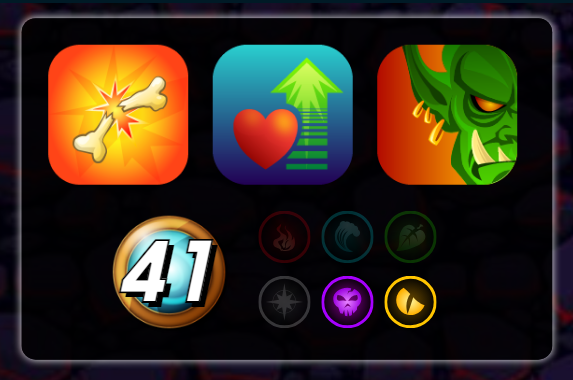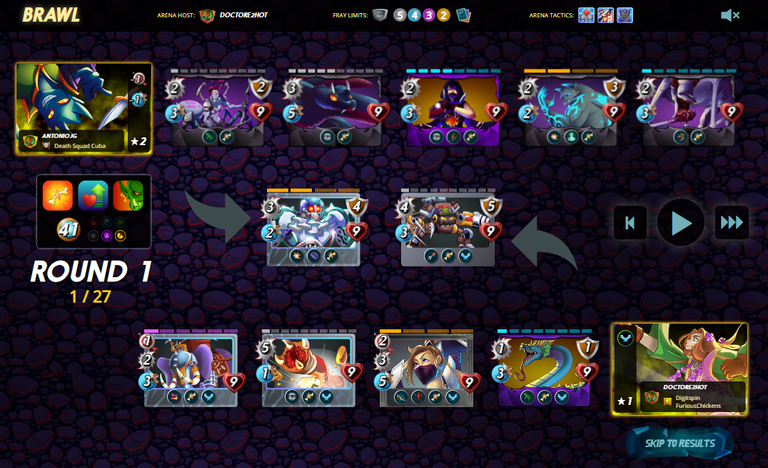Una estrategia interesante combinando a los Splinters Muerte & Dragon en una batalla con las reglas Tis but Scratches and Up Close & Personal [Es/En]

Español
¡Saludos comunidad! En el reto de esta semana quiero compartir con ustedes un análisis de mi experiencia utilizando una estrategia combinando a los Splinters Muerte y Dragón. La cual considero una excelente opción para aquellas partidas con un límite de maná alto y con los rulesets “Tis but Scratches” y “Up Close & Personal”. Es importante recordar que el tipo de ofensiva a utilizar en nuestras estrategias también dependerá del resto de reglas presentes en la batalla.
En esta oportunidad, les explicaré cómo afronté una batalla de Brawl de la liga de Plata en el formato Salvaje, enfocando mi análisis en explicar cómo combiné a los Splinters de Muerte y Dragón, el invocador Quix The Devious y a las unidades Chain Golem, Arachne Thug, Silent Sha-vi, Dhampir Infiltrator, Harklaw y Cursed Windeku para ser coherente con las reglas de batalla presentes y las habilidades que quería combinar con la finalidad de tomar ventaja en la partida con la estrategia planteada.
Ya que estos aspectos son un factor clave con un impacto considerable en el desempeño de nuestras estrategias.

Conjunto de reglas y elección

Hablemos sobre el conjunto de reglas presentes en la batalla, este es el punto de partida para iniciar el análisis que nos llevará a la elección más adecuada para afrontar la batalla.
Límite de maná igual a 41 puntos, esta cantidad nos permite elegir invocadores con un costo de maná entre 4 y 7 puntos. Dejándonos con una cantidad de maná restante suficiente para elegir a las unidades adecuadas.
“Tis but Scratches”, es una regla que otorga a todas las unidades la habilidad “Cripple”. Por otra parte, “Equalizer”, iguala la vida de todas las unidades a la cantidad de vida más alta entre ambos equipos. Mientras que “Up Close & Personal”, sólo permite utilizar unidades de tipo melee, cabe destacar que incluye a las unidades con dos tipos de ataque, de los cuales uno de ellos sea melee.
Entonces, tomando en cuenta todos estos aspectos, decidí combinar a los Splinters de Muerte y Dragón, ya que cuentan con unidades que poseen buenas estadísticas, entre ellas, un buen daño melee. También cuentan con habilidades como: “Shield”, “Reach”, “Sneak”, “Double Strike”, “Immunity”, “Thorns”, entre otras y con un invocador que reduce en 1 punto la velocidad y ataque ranged del enemigo.

Equipo y estrategia

Hablemos sobre el equipo y la estrategia que conforma. Dadas las circunstancias, era evidente el uso del tipo de ataque melee. Es por ello que decidí elegir al invocador Quix the Devious, ya que reduce en 1 punto la velocidad y ataque ranged del enemigo.
Chain Golem fue el tanque en esta oportunidad, porque cuenta con buenas estadísticas, entre ellas, sus puntos de armadura, vida y ataque. También, posee la habilidad “Shield”, la cual le permite reducir el daño melee recibido.
Arachne Thug contribuye con su ataque desde la segunda posición a través de la habilidad “Reach”, lo que ayuda al tanque a debilitar a las unidades enemigas en la primera posición.
Silent Sha-Vi se encarga de debilitar a las unidades enemigas en las últimas posiciones, a través de la habilidad “Sneak”.
Dhampir Infiltrator tiene el mismo propósito que Silent Sha-Vi pero con la diferencia que la habilidad “Double Strike” le permite atacar dos veces por turno.
Harklaw es una unidad clave en la estrategia, ya que las habilidades “Shield” e “Immunity” le permiten resistir el daño melee y los efectos de la habilidad “Cripple”. De tal manera que puede proteger al equipo de los ataques tipo “Sneak”.
Cursed Windeku tiene un propósito similar al de Harklaw pero con la diferencia que hace un daño residual a través de la habilidad “Thorns”.

Estrategia en acción

Como les mencioné anteriormente, elegir al invocador Quix the Devious y a las unidades Chain Golem, Arachne Thug, Silent Sha-vi, Dhampir Infiltrator, Harklaw y Cursed Windeku fue una buena opción. Sin embargo, también es importante incluir habilidades de soporte que le permitan a nuestro tanque y al resto del equipo, resistir lo suficiente.
Observen como para el turno 5 de la ronda 5, el equipo enemigo estaba casi abatido. Chain Golem y Arachne Thug resistieron lo suficiente en las primeras posiciones para dar tiempo a Silent Sha-Vi y Dhampir Infiltrator para debilitar al enemigo. Del mismo modo, Cursed Windeku y Harklaw protegieron al equipo de los ataques Sneak enemigos.
Si quieres ver la batalla completa, acá te dejo el enlace: CLIC PARA VER LA BATALLA

Conclusión
La estrategia planteada hizo un uso eficiente de la cantidad de maná disponible, cubriendo aspectos tales como: resistencia contra el daño enemigo, soporte del equipo, una buena ofensiva, y coherencia con el conjunto de reglas presente.
Una debilidad de esta estrategia es un equipo enemigo que cuente con resistencia al daño melee e incluya habilidades de soporte como: “Protect”, “Repair”, “Heal”, “Shield”, “Triage”, “Immunity”, entre otras.
La diferencia entre las estrategias fue que el equipo enemigo no contaba con las habilidades de soporte suficientes y el daño de su ofensiva no era tan elevado, por lo que terminó siendo abatido.
Para el funcionamiento adecuado de nuestras estrategias, es importante considerar todos los aspectos involucrados, por lo que no sólo debemos enfocarnos en las estadísticas y habilidades a combinar. También debemos tener en cuenta la influencia de los conjuntos de reglas sobre la estrategia.
Este ha sido mi aporte al desafío semanal, ¡Espero haya sido de su agrado! ¡Saludos y hasta la próxima semana!

English
Greetings community! In this week's challenge I want to share with you an analysis of my experience using a strategy combining Death and Dragon Splinters. Which I consider an excellent option for those games with a high mana limit and with the rulesets “Tis but Scratches” and “Up Close & Personal”. It is important to remember that the type of offensive to use in our strategies will also depend on the rest of the rules present in the battle.
In this opportunity, I will explain how I faced a Silver League Brawl battle in the Wild format, focusing my analysis in explaining how I combined the Death and Dragon Splinters, the summoner Quix The Devious and the units Chain Golem, Arachne Thug, Silent Sha-vi, Dhampir Infiltrator, Harklaw and Cursed Windeku to be coherent with the battle rules present and the abilities I wanted to combine in order to take advantage in the game with the strategy proposed.
Since these aspects are a key factor with a considerable impact on the performance of our strategies.

Rulesets and choise

Let's talk about the set of rules present in the battle, this is the starting point to begin the analysis that will lead us to the most appropriate choice to face the battle.
Mana limit equal to 41 points, this amount allows us to choose summoners with a mana cost between 4 and 7 points. Leaving us with a sufficient amount of remaining mana to choose the right units.
“Tis but Scratches”, is a rule that grants all units the ability ‘Cripple’. On the other hand, “Equalizer”, equalizes the life of all units to the highest amount of life between both teams. While “Up Close & Personal” only allows the use of melee type units, it should be noted that it includes units with two attack types, one of which is melee.
So, taking into account all these aspects, I decided to combine Death and Dragon Splinters, since they have units with good stats, including good melee damage. They also have abilities such as: “Shield”, “Reach”, “Sneak”, “Double Strike”, “Immunity”, “Thorns”, among others, and a summoner that reduces the enemy's speed and ranged attack by 1 point.

Team and strategy

Let's talk about the team and its strategy. Given the circumstances, it was obvious to use the melee attack type. That's why I decided to choose the summoner Quix the Devious, since it reduces the enemy's speed and ranged attack by 1 point.
Chain Golem was the tank in this opportunity, because it has good stats, among them, its armor, life and attack points. Also, he has the “Shield” ability, which allows him to reduce the melee damage received.
Arachne Thug contributes with his attack from the second position through the “Reach” ability, which helps the tank to weaken enemy units in the first position.
Silent Sha-Vi is in charge of weakening enemy units in the last positions, through the “Sneak” skill.
Dhampir Infiltrator has the same purpose as Silent Sha-Vi but with the difference that the ability “Double Strike” allows him to attack twice per turn.
Harklaw is a key unit in the strategy, as the “Shield” and “Immunity” abilities allow him to resist melee damage and the effects of the “Cripple” ability. Thus, it can protect the team from “Sneak” attacks.
Cursed Windeku has a similar purpose to Harklaw but with the difference that it does residual damage through the “Thorns” ability.

Strategy in action

As I mentioned before, choosing the summoner Quix the Devious and the units Chain Golem, Arachne Thug, Silent Sha-vi, Dhampir Infiltrator, Harklaw and Cursed Windeku was a good choice. However, it is also important to include support abilities that allow our tank and the rest of the team to resist enough.
Note how by turn 5 of round 5, the enemy team was almost down. Chain Golem and Arachne Thug held out long enough in the early positions to give Silent Sha-Vi and Dhampir Infiltrator time to weaken the enemy. Likewise, Cursed Windeku and Harklaw protected the team from enemy Sneak attacks.
If you want to see the complete battle, here you have the link: CLICK TO WATCH THE BATTLE

Conclusion
The strategy proposed made an efficient use of the amount of mana available, covering aspects such as: resistance against enemy damage, team support, a good offensive, and coherence with the present set of rules.
A weakness of this strategy is an enemy team that has resistance to melee damage and includes support abilities such as: “Protect”, “Repair”, “Heal”, “Shield”, “Triage”, “Immunity”, among others.
The difference between the strategies was that the enemy team did not have enough support skills and the damage of their offensive was not so high, so they ended up being defeated.
For the proper functioning of our strategies, it is important to consider all the aspects involved, so we should not only focus on the statistics and skills to combine. We must also take into account the influence of the rule sets on the strategy.
This has been my contribution to the weekly challenge, I hope you enjoyed it, greetings and see you next week!

Te invito a seguirme en / I invite you to follow me on: Twitter
Las traducciones fueron realizadas con el traductor / Translations were done with the translator: DeepL
Todas las imágenes fueron tomadas de / and all images were taken from: Splinterlands

https://www.reddit.com/r/Splinterlands/comments/1g5x8em/una_estrategia_interesante_combinando_a_los/
The rewards earned on this comment will go directly to the people( @antoniojg ) sharing the post on Reddit as long as they are registered with @poshtoken. Sign up at https://hiveposh.com. Otherwise, rewards go to the author of the blog post.
https://x.com/AntonioJGB92/status/1846975226913214556
Thanks for sharing! - @underlock

¡Gracias! | Thanks! ✌️